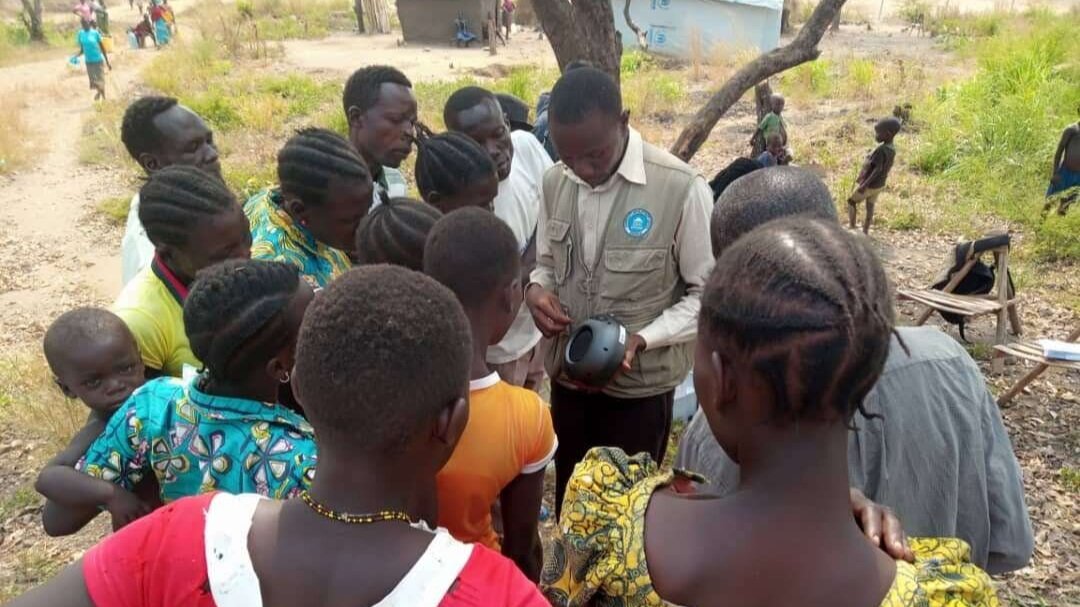Demonstrating the speakerbox. Omugo zone. Photo: Community Develoment Centre (CDC), 2020
Just over a week ago, the Soot Semee team in Northern Uganda handed out first Soot Semee podcasts on memory cards to a community of South Sudanese refugees. At the same time, they distributed speakerboxes so that over 100 groups of around 10-20 people each can listen to the podcasts together. One of the community members said
Marketplace speakerbox. Omugo zone. CDC 2020
"This is a bright and beautiful day for us in [our community]...these speakerboxes would be to us a school and that kind of voice we missed in the community.“
In the community trading centre, Soot Semee set up a large PA-sized speakerbox to play the podcasts. Barnabas from Soot Semee told me:
“We learned from the trading centre that people with smart phones came to transfer [the podcast] to their phones. Listening groups are also contributing content this time and we had a lot of recordings.”
Over 1000 people will have listened in the first week. I also had a chance to listen! And the first episode certainly started with plenty energy and ambition!
What’s in a podcast?
Right from the start the podcast is packed with community voices. Soot Semee aims to build peace in communities that have suffered too long from conflict. Local journalists start the podcast off with a roundup of the week’s news from South Sudan, keeping people up to date with the peace process. Local musicians sing a song promoting peace. Villagers introduce themselves and share their opinions on issues affecting their day to day lives. NGOs and local government offices provide information about services and job opportunities.
Refugee voices
A community leader tells us that a big problem facing her neighbourhood is the lack of water. Tank 53 is shared between the host and refugee communities. The water needs to be boiled before being safe to drink. Most families only have one saucepan which they use for cooking. And there is a shortage of firewood. So how can they boil the water? She feels frustrated by unfulfilled promises made to provide new water sources. They want to live peacefully alongside the host communities, but both communities feel the tension as access to resources gets more difficult.
South Sudanese refugees collect water. Bidi Bidi, Northern Uganda. Photo: HCR, 2019
Host communities
Next is an interview with a Ugandan community member who also gets water from Tank 53. He explains that they treat their water with a purification solution before drinking. He goes on to talk about normal practices of locals charging a fee to help at a key river crossing. The language barrier is clear between interviewer and interviewee so there is a lot of double checking what each other actually said. But they persevere because it’s important for the refugees to understand the norms, so conflicts don’t flare up over people feeling exploited.
Soot Semee interviews community members at river crossing. Omugo zone. Photo: CDC, 2020
Water drama
The podcast finishes with a tense drama produced and acted by a local drama team. Opening with the sound of running water we are soon immersed in a heated argument in a language I don’t understand. But for sure, we are back to the issue of water. In the drama an NGO worker arrives who doesn’t speak the local language, so he speaks English. A community leader translates for him. She calls people together and they have a meeting to hear what the community wants, and to help them come up with ideas that could help reduce the tension. The meeting finishes and a much more relaxed conversation happens around the running water. It’s a drama. But it reflects the hope and real possibility that community members will find a way for peaceful co-existence.
Hope for the future
The first programme has set a high bar! But people in these communities know all too personally, the price of conflict, and they seem determined to make the most of the opportunity for building peace that is offered through the Soot Semee podcasts.
This week, as the team came back to the community, they found people were waiting for them
“with joy and happiness to receive the next [podcast].”
At HCR, we are also hopeful that these podcasts become a tool for lasting peace as people continue to restore shattered lives together.




